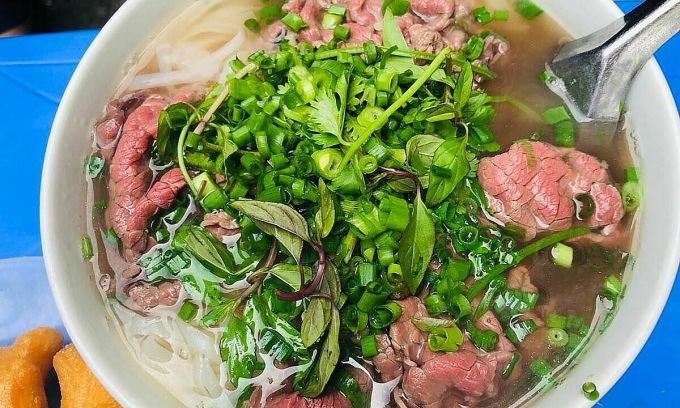Vietnam’s dynamic food culture enchants locals and tourists with an array of street eats, creating a blend of flavors for everyone to savor.
TasteAtlas, an online food magazine, has revealed a list of Vietnam’s top 8 street foods that is perfect for adventurous travelers exploring the country.
1. Pho
TasteAtlas described pho as more than just a Vietnamese noodle soup – it’s a cultural icon, a favorite street food, and a satisfying comfort. Traditionally, it’s crafted from simmered chicken or beef broth, patiently cooked for over three hours. A medley of herbs and spices enhances the taste, while rice noodles, beef, and sprouts take the dish to new heights.
The most popular variety, beef pho, uses different cuts of beef, like bones, shank, oxtail, and neck for the broth, while toppings include brisket, flank, eye-round steak, tripe, raw and cooked beef, tendon. In southern Vietnam, a popular topping that sets it apart from other areas is beef balls.
Chicken pho features various chicken parts, with lighter broth than beef pho. It’s often garnished with lime, mint, chili, bean sprouts, and basil. This pho variety was believed to be created in the 1930s when beef was scarce.
2. Banh mi
Banh mi are Vietnamese sandwiches with a common type of bread – a baguette. The baguette was introduced to Vietnam during the colonial era and remains an influence from that time. The crispy baguette, toppings, and meats are traces of French and Chinese colonial history, while cilantro, chili, and pickles showcase Vietnamese preferences for flavors and vegetables.
Variations abound across different regions, showcasing diverse fillings such as pate, fried eggs, and different types of cold cuts such as pork rolls, sausages, and ham. Served alongside fresh herbs, pickled vegetables, and chili sauce, banh micaters to all tastes.
3. Fried spring rolls
In Vietnam, these delicious treats go by two names: cha gio in the south and nem ran in the north. These rolls are typically filled with a mixture of pork and shrimp, wrapped in rice paper.
Often, they’re enhanced with ingredients like carrots, cabbage, mushrooms, glass noodles, and bean sprouts. After a quick fry, they emerge with a golden hue, a thin, crispy outer layer, and a delightful filling. They are served hot, accompanied by sweet fish sauce, herbs, and rice or vermicelli.
4. Banh xeo (Crispy pancakes)
Banh xeo, also known as sizzling pancakes, is a Vietnamese dish that merges crispy crepes with savory components. A key Vietnamese touch is the use of rice flour, blended with water, turmeric, and coconut milk or cream, resulting in a rich yellow batter.
After stir frying ingredients like scallions, bean sprouts, shrimps, and pork or beef, the mixture is poured onto a pan. Cooked over low heat, the pancake is then folded in half, enveloping the fillings within. It is commonly served with sweet fish sauce or savory peanut sauce.
5. Sticky rice
Sticky rice comes in countless variations and is readily available from roadside stalls to upscale eateries. Created using steamed sticky rice, it offers both savory and sweet options.
Traditionally wrapped in a banana leaf, sticky rice is often enjoyed as an affordable breakfast or a midday snack. Common ingredients for savory sticky rice include pork rolls, Chinese sausage, shredded chicken, dried shrimps, and pork or chicken floss. Meanwhile, sweet sticky rice can include fruits like mango, red sweet gourd, durian, and coconut, as well as mung beans and cassava.
6. Banh beo (Steamed rice cake)
Banh beo is a steamed cake made from rice flour, served with fish sauce, green chili peppers, and either shrimps or pork. Regional variations incorporate roasted peanuts, fried onions, or shrimp for heightened flavor.
In addition to the savory cakes, there are sweet versions mainly found in Hoi An. It’s typically served on small porcelain plates, around 5-6 cm in diameter in the central region, but larger ones can be found in Hai Phong. An important feature of a good banh beo is a central indentation that holds the savory fillings.
7. Banh cuon (Steamed rice rolls)
Banh cuon is a street food made of thin, steamed rice rolls filled with pork, mushrooms, or both. It’s often topped with a generous amount of fried shallots, and served with sweet and sour fish sauce, as well as fresh herbs. Creating these see-through steamed rolls requires expertise. In Vietnam, it is commonly enjoyed for breakfast.
8. Com tam (Broken rice)
Com tam is a Vietnamese street food made from broken rice grains that used to be discarded after milling. The rice has a texture similar to regular rice, just smaller. The dish is served with various toppings like fried eggs, shredded pork skin, grilled pork chops, or deep-fried fish patties. It’s garnished with scallion oil, and often comes with side dishes like sliced tomatoes, cucumbers, pickled vegetables, and a side of sweet fish sauces.
Diners can easily spot com tam stalls by the coal-fired grill on the street, giving off a fragrant aroma of charred meat from preparing the dish. In the past, these rice grains were either used as animal feed or consumed by farmers and their families.
